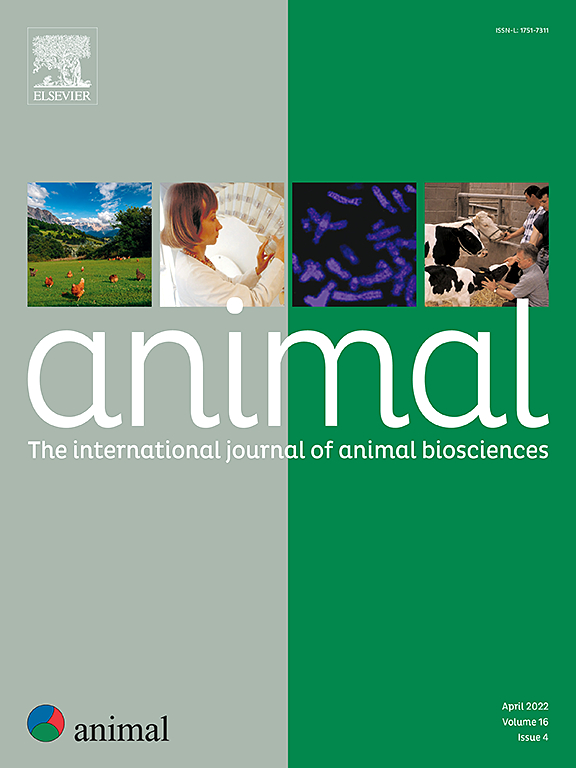Characterising nosing behaviours in pigs after mixing using social network analysis
IF 4.2
2区 农林科学
Q1 AGRICULTURE, DAIRY & ANIMAL SCIENCE
引用次数: 0
Abstract
Affiliation as indicated by proximity has, to date, been used as the principal measure of positive relationships in farm animals. However, intensive housing may present a caveat to using proximity as a representation of affiliation as animals may be forced into proximity by stocking densities. To investigate affiliation patterns, this study examined differences in the expression of proximity and contact behaviours following regrouping in pigs. Animals (61 males and 56 females) were observed across eight groups (14.6 ± 0.69 SD pigs/group). Each group comprised a mix of familiar and unfamiliar finishing pigs (12 weeks old). Video observations occurred for two consecutive days following regrouping. Individuals were continuously observed for social nosing behaviour for 2 h in total, balanced across days. Social network analysis of directed networks provided group-level information including weighted degree centrality and density. Exponential Random Graph Models fitted to these networks were used to consider the underpinning social processes including reciprocity, homophily, and the effect of individual attributes. Groups differed in the expression of behaviours, whilst, at the global level, density was significantly lower (P < 0.001) for the snout-snout (0.68 ± 0.15 SD) than snout-head (0.92 ± 0.04 SD) proximity networks. Statistically significant differences were also shown in the density across the contact networks (P < 0.001) with the lowest cohesion in the snout-snout (0.33 ± 0.14 SD), compared to the snout-head (0.52 ± 0.07 SD), and snout-body (0.66 ± 0.09 SD) contact networks. Familiarity was a predictor of interaction (P = 0.0001) across behaviours. Familiar pigs were nearly twice as likely to assort in the contact networks and three times more likely to assort in the snout-snout and snout-head proximity networks. Sex was not a predictor of snout proximity; however, females received significantly less behaviour than males in the snout-snout (odds ratio (OR): 0.78, P = 0.046), and snout-head (OR: 0.69, P = 0.001) contact networks. Snout proximity behaviours showed significant reciprocity (snout head: OR = 2.56; P = 0.008; snout-snout: OR = 2.80; P = 0.0001). Contact behaviours showed significant reciprocity in the snout-snout (OR = 2.40; P = 0.0001), and snout-head (OR = 1.55; P = 0.004) networks. Our study highlights behavioural nuances, with groups differing in snout proximity and contact patterns, in which reciprocation is normal behaviour, and snout-snout proximity and snout-snout contact are the least observed. Furthermore, it shows the influence of attributes on network structure to inform grouping strategies.
使用社会网络分析混合后猪的鼻子行为特征
迄今为止,由接近程度所表示的亲缘关系已被用作农场动物之间积极关系的主要衡量标准。然而,密集的住房可能会提出一个警告,使用接近作为从属关系的代表,因为动物可能被迫接近饲养密度。为了研究隶属关系模式,本研究检查了猪重组后接近和接触行为表达的差异。共分8组(14.6±0.69头/组),公猪61头,母猪56头。每组由熟悉和不熟悉的育肥猪组成(12周龄)。重组后连续两天进行视频观察。连续观察个体的社交鼻子行为共2小时,在几天内保持平衡。有向网络的社会网络分析提供了群体层面的信息,包括加权度中心性和密度。指数随机图模型适用于这些网络,用于考虑基础社会过程,包括互惠、同质性和个体属性的影响。各组在行为表达上存在差异,而在全球水平上,密度明显较低(P <;鼻-鼻网络(0.68±0.15 SD)比鼻-头网络(0.92±0.04 SD)更接近。在接触网络的密度上也显示出统计学上的显著差异(P <;0.001),与鼻-头(0.52±0.07 SD)和鼻-身(0.66±0.09 SD)接触网络相比,鼻-口的内聚性最低(0.33±0.14 SD)。熟悉度是行为相互作用的预测因子(P = 0.0001)。熟悉的猪在接触网络中进行组合的可能性几乎是两倍,在鼻子-鼻子和鼻子-头接近网络中进行组合的可能性是三倍。性别并不能预测鼻子的接近程度;然而,雌性在鼻子-鼻子(优势比(OR): 0.78, P = 0.046)和鼻子-头(OR: 0.69, P = 0.001)接触网络中的行为明显少于雄性。鼻子接近行为具有显著的互易性(鼻子头部:OR = 2.56;p = 0.008;snout-snout: OR = 2.80;p = 0.0001)。鼻-鼻接触行为表现出显著的互易性(OR = 2.40;P = 0.0001),鼻头(OR = 1.55;P = 0.004)网络。我们的研究强调了行为的细微差别,不同的群体在鼻子接近和接触模式上有所不同,其中互惠是正常的行为,而鼻子接近和鼻子接触是最少观察到的。进一步分析了属性对网络结构的影响,为分组策略提供依据。
本文章由计算机程序翻译,如有差异,请以英文原文为准。
求助全文
约1分钟内获得全文
求助全文
来源期刊

Animal
农林科学-奶制品与动物科学
CiteScore
7.50
自引率
2.80%
发文量
246
审稿时长
3 months
期刊介绍:
Editorial board
animal attracts the best research in animal biology and animal systems from across the spectrum of the agricultural, biomedical, and environmental sciences. It is the central element in an exciting collaboration between the British Society of Animal Science (BSAS), Institut National de la Recherche Agronomique (INRA) and the European Federation of Animal Science (EAAP) and represents a merging of three scientific journals: Animal Science; Animal Research; Reproduction, Nutrition, Development. animal publishes original cutting-edge research, ''hot'' topics and horizon-scanning reviews on animal-related aspects of the life sciences at the molecular, cellular, organ, whole animal and production system levels. The main subject areas include: breeding and genetics; nutrition; physiology and functional biology of systems; behaviour, health and welfare; farming systems, environmental impact and climate change; product quality, human health and well-being. Animal models and papers dealing with the integration of research between these topics and their impact on the environment and people are particularly welcome.
 求助内容:
求助内容: 应助结果提醒方式:
应助结果提醒方式:


